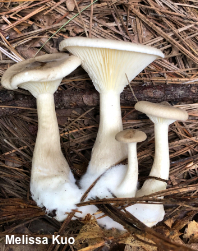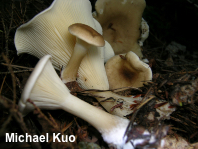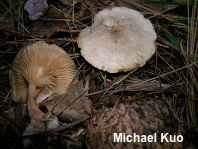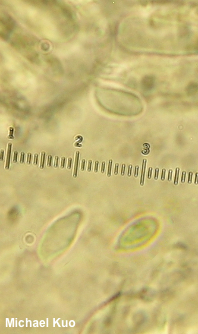| Major Groups > Gilled Mushrooms > Pale-Spored > Clitocyboid Mushrooms > Ampulloclitocybe clavipes |

|
Ampulloclitocybe clavipes [Basidiomycota > Agaricales > Hygrophoraceae > Ampulloclitocybe...] by Michael Kuo Among the clitocyboid mushrooms, Ampulloclitocybe clavipes is distinguished by its grayish brown cap, its white spore print, its frequently bulbous stem, its (usual) preference for conifers, and microscopic features (including its smooth spores and the presence of clamp connections) . . . which is another way of saying that the species is not very easy to identify with certainty without the use of a microscope, since many clitocyboid mushrooms look similar to the naked eye. The bulbous stem is what gives the species its name (clavipes), but it is not always as bulbous as it is in field guide photos, and this is especially the case with older specimens. Many authors attempt to illustrate the swollen stem base, since it is one of the defining features of the mushroom, but I sometimes wonder how many non-swollen mushrooms were discarded in the search for "typical" specimens to photograph. Clitocybe clavipes is a well known synonym. The relatively recent genus Ampulloclitocybe was established to reflect the fact that DNA studies have placed this mushroom and closely related species far from the bulk of the Clitocybe species, in the Hygrophoraceae. Description: Ecology: Treated as saprobic by some authors, and as mycorrhizal by others; growing alone, scattered, or gregariously; primarily appearing under conifers, but sometimes reported under hardwoods; originally described from Europe; widely distributed throughout Europe and Asia; in North America widely distributed but apparently absent or very rare in the lower Rocky Mountains and the southwestern United States; also found in Australia. The illustrated and described collections are from Michigan and Wisconsin. Cap: 2–10 cm across; at first flat with a slightly underturned margin, eventually becoming centrally depressed or vase-shaped, with an uplifted margin; smooth, or somewhat rugged over the center; bald; moist or dry; brown to grayish brown—usually darker over the center and lighter towards the margin by maturity. Gills: Running down the stem; close or nearly distant; short-gills frequent; white to creamy, becoming brownish in old age. Stem: 2.5–5 cm long; 1–3 cm thick at the base; often bulbous at the bottom, but sometimes more or less equal, especially with age; bald or minutely hairy; often spongy at the base; buff or pale brownish; basal mycelium white. Flesh: White; unchanging when sliced. Odor and Taste: Odor fragrant and fruity—or not distinctive; taste not distinctive. Chemical Reactions: KOH negative on cap surface. Spore Print: White. Microscopic Details: Spores 6–10 x 3–3.5 µm; ellipsoid to egg-shaped or elongated-ellipsoid, occasionally with a narrowed end; smooth; hyaline in KOH; inamyloid. Basidia 27–36 x 6–7 µm; subclavate; 4-sterigmate. Pseudocystidia scattered as "marginal cells" in some specimens; 22–26 x 10–15 µm; clavate to sphaeropedunculate; smooth; hyaline in KOH. Pileipellis a cutis of elements 5–12 µm wide, smooth, thin-walled, hyaline in KOH; clamp connections present. REFERENCES: (Persoon, 1801) Redhead, Lutzoni, Moncalvo & Vilgalys, 2002. (Fries, 1821; Saccardo, 1887; Kauffman, 1918; Harmaja, 1969; Cochran & Cochran, 1978; Smith, Smith & Weber, 1979; Phillips, 1981; Bigelow, 1982; Weber & Smith, 1985; Arora, 1986; Breitenbach & Kränzlin, 1991; Phillips, 1991/2005; Schalkwijk-Barendsen, 1991; Lincoff, 1992; Kuyper, 1995; Barron, 1999; Nonis, 2001; Redhead et al., 2002; Roody, 2003; McNeil, 2006; Miller & Miller, 2006; gregory, 2007; Trudell & Ammirati, 2009; Buczacki et al., 2012; Lodge et al., 2013; Kuo & Methven, 2014; Siegel & Schwarz, 2016; Baroni, 2017; Elliott & Stephenson, 2018; Sturgeon, 2018; Vesterholt, 2018; Læssøe & Petersen, 2019; McKnight et al., 2021.) Herb. Kuo 09130405, 09220406. This site contains no information about the edibility or toxicity of mushrooms. |
© MushroomExpert.Com |
|
Cite this page as: Kuo, M. (2021, April). Ampulloclitocybe clavipes. Retrieved from the MushroomExpert.Com Web site: http://www.mushroomexpert.com/ampulloclitocybe_clavipes.html |



